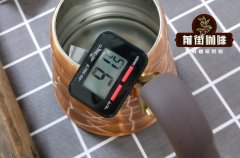What is the meaning of roasting coffee beans? The three stages of roasting coffee beans
The significance of coffee roasting
Basically, coffee roasting is a kind of hot Pyolysis roasting that completely changes the substance inside the raw bean, produces new compounds and recombines to form aroma and mellow flavor. This effect only happens at high temperature, but it cannot be decomposed if only low temperature is used, no matter how long the coffee beans are roasted.
Most people think that baking is nothing but cooking raw beans with fire. In fact, roasting is the most difficult step in the processing of coffee.
Baking can be divided into three stages:
(1) drying
(2) High temperature decomposition
(3) cooling
(1) drying
In the early stage of baking, raw beans begin to absorb heat, and the internal water gradually evaporates, when the color gradually changes from cyan to yellow or light brown, and the silver film begins to fall off, and a faint smell of grass can be smelled. This stage is mainly to remove moisture, accounting for about half of the baking time.
Because water is a good heat transfer conductor, it helps to roast the internal substance of coffee beans, although it is removing water, but the baker will make good use of the temperature of the water and properly control it so that it will not evaporate too fast. usually, it is best to control the water to reach the boiling point at 10 minutes and change to steam, when the internal material will be fully cooked and the water will begin to evaporate out of the outside of the coffee beans.
(2) High temperature decomposition
When the beans are roasted to about 160 degrees Celsius, the water inside will evaporate into gas and begin to blow out the outside of the coffee beans. At this time, the inside of the beans will change from endothermic to exothermic to produce the first burst sound. After the bursting sound, it will turn to endothermic, and the pressure inside the coffee bean is extremely high, reaching 25 atmospheres.
High temperature and pressure begin to deconstruct the original tissue to form new compounds, creating the taste and taste of coffee, reaching about 190 degrees, and the conversion between endothermic and exothermic heat will occur again.
Of course, high temperature cracking is still occurring continuously, coffee beans change from brown to dark brown, and gradually enter the stage of re-baking.
(3) cooling Quenching
Coffee must be cooled immediately after roasting, quickly stop the high temperature cracking and lock the flavor, otherwise the high temperature inside the beans will continue to work and will burn off the aromatic substances.
Important Notice :
前街咖啡 FrontStreet Coffee has moved to new addredd:
FrontStreet Coffee Address: 315,Donghua East Road,GuangZhou
Tel:020 38364473
- Prev

How important is the quality of a good cup of coffee? How does water quality affect the aroma and taste of coffee
The importance of coffee water quality the water content in a cup of coffee is more than 98%, and brewing is the last step in making coffee. The high quality of selected coffee requires more correct brewing techniques and skills, so the quality of water quality is very important. Generally speaking, the water quality with slightly higher hardness but not too high water quality is the most suitable for brewing coffee. The minerals in the water can match the internal substances of the coffee.
- Next

Costa Rican Richiuzhuang map presents the flavor and characteristics of yellow honey-treated Vilasaki coffee
Finca Licho is an impressive coffee family. About 60 years ago, Edgar Aquilera Bonilla, the first owner of the house, came to Naranjo in the Western Valley and started coffee growing. He was succeeded by his son Felipe Aguilera Gonzle, who is currently Aguilera III.
Related
- Beginners will see the "Coffee pull flower" guide!
- What is the difference between ice blog purified milk and ordinary milk coffee?
- Why is the Philippines the largest producer of crops in Liberia?
- For coffee extraction, should the fine powder be retained?
- How does extracted espresso fill pressed powder? How much strength does it take to press the powder?
- How to make jasmine cold extract coffee? Is the jasmine + latte good?
- Will this little toy really make the coffee taste better? How does Lily Drip affect coffee extraction?
- Will the action of slapping the filter cup also affect coffee extraction?
- What's the difference between powder-to-water ratio and powder-to-liquid ratio?
- What is the Ethiopian local species? What does it have to do with Heirloom native species?

